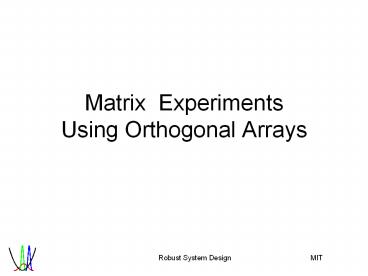MatrixExperiments Using Orthogonal Arrays - PowerPoint PPT Presentation
1 / 15
Title:
MatrixExperiments Using Orthogonal Arrays
Description:
Explain how to analyze data from matrix experiments ... One factor at a time. Estimated response at. ? Orthogonal array. Estimated response at A3 is ... – PowerPoint PPT presentation
Number of Views:97
Avg rating:3.0/5.0
Title: MatrixExperiments Using Orthogonal Arrays
1
Matrix ExperimentsUsing Orthogonal Arrays
2
Comments on HW2 and Quiz1 Questions on the
Reading Quiz Brief Lecture Paper Helicopter
Experiment
3
Learning Objectives
- Introduce the concept of matrix experiments
- Define the balancing property and orthogonality
- Explain how to analyze data from matrix
experiments - Get some practice conducting a matrix experiment
4
Static Parameter Design and theP-Diagram
Noise Factors
Induce noise
Product / Process
Signal Factor
Response
Optimize
Hold constant for a static experiment
Control Factors
Vary according to MIT an experimental plan
5
Parameter Design Problem
- Define a set of control factors (A,B,C)
- Each factor has a set of discrete levels
- Some desired response h (A,B,C) is to be
maximized
6
Full Factorial Approach
- Try all combinations of all levels of the
factors (A1B1C1, A1B1C2,...) - If no experimental error, it is guaranteed to
find maximum - If there is experimental error, replications
will allow increased certainty - BUT ... experiments levelscontrol factors
7
Additive Model
- Assume each parameter affects the response
independently of the others - h( Ai , B j , Ck , Di ) m ai b j ck
di e - This is similar to a Taylor series expansion
8
One Factor at a Time
9
Orthogonal Array
10
Notation for Matrix Experiments
Number of experiments
Number of levels
Number of factors
9(3-1)x41
11
Why is this efficient?
- One factor at a time
- Estimated response at
- Orthogonal array
- Estimated response at A3 is
- Variance sums for independent errors
- Error variance 1/replication number
12
Factor Effect Plots
- Which CF levels will you choose?
- What is your scaling
- factor?
Factor Effects on the Mean
Factor Effects on the Variance
13
Prediction Equation
Factor Effects on the Variance
14
Inducing Noise
Control Factors
Expt. No.
Noise factor
15
Analysis of Variance (ANOVA)
- ANOVA helps to resolve the relative magnitude
of the factor effects compared to the error
variance - Are the factor effects real or just noise?
- I will cover it in Lecture 7
- You may want to try the Mathcad resource
center under the help menu































